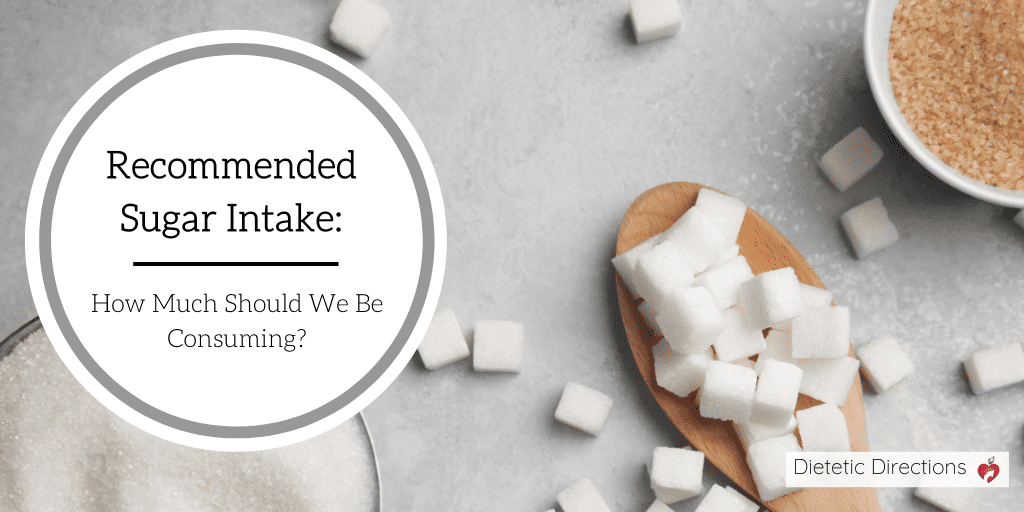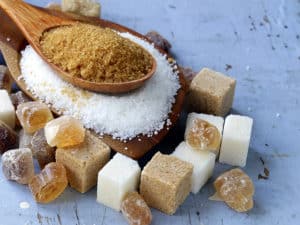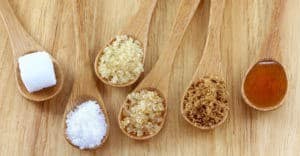
Recommended Sugar Intake:
How Much Should We Be Consuming?
Yesterday, the Heart and Stroke Foundation of Canada issued a new position statement recommending adults and children limit the consumption of added sugars to no more than 10% of their daily calorie intake. This recommendation equates to 12 teaspoons of added sugar daily, which is less than half of the current average intake of 25 teaspoons of added sugars daily! Yikes! Our current sugar intake is the equivalent to a person consuming 20 bags of sugar a year. Something has certainly got to give.

This position statement thankfully comes at a time when the public seems aware and receptive to the harmful health implications of excess sugar. We previously thought of sugar mainly as empty calories with links to weight gain. Today, the health consequences far exceed this simplistic association. Excess sugar is linked to heart disease, stroke, obesity, diabetes, high cholesterol, cancer and cavities. In fact, a February publication in the Journal of the American Medical Association found that people who consume more than 10% of their daily calories from added sugars have a 30% higher risk of dying from heart disease or stroke. This is especially concerning considering the average Canadian consumes 20% of their daily calories from this sweet substance.
To put the sugar recommendations into context, based on a 2,000 calorie a day diet, 10% of daily calories would be 200 calories from added sugar. Keep in mind this is not a recommendation as much as it is a limit! One teaspoon of sugar has 16 calories so this is equal to 12.5 teaspoons of added sugar.
Know How Many Teaspoons of Sugar Based on Food Label!
When looking at food labels to check the sugar content, look at the line for sugar to see the amount in grams. Now, remember that one teaspoon of sugar is 4 grams! Therefore, to calculate how many teaspoons of sugar are in a product, simply divide by 4. Therefore, if you are taking a look at a 355mL can of coke, you will see it has 40g of sugar. Divide the 40g of sugar by 4g to get 10 teaspoons of added sugar. When counselling clients, I encourage them to be able to put the recommendations into context by knowing how much sugar is in their food.
Added sugars should be limited to no more than 10% of daily calorie intake (Heart & Stroke) Share on XWhat are “Added Sugars”?
Added sugars are sugars that are added to foods and drinks in the manufacturing process.
Added sugars include:
- Glucose
- Fructose
- Sucrose
- Brown sugar
- Honey
- Corn syrup
- Maple syrup
- Molasses
- Fruit puree & Juice.
Dietitian Tip: Check the ingredient list on food products to see what ingredients are added to sweeten the product.
How about “Naturally Occurring” Sugars?
Sugars are found naturally found in many foods like fruit, milk, vegetables and other wholesome foods like grains and legumes. These are NOT considered to be added sugars. Continue to enjoy natural sugar sources in your diet since they also provide many vitamins and nutrients for health.
Bottom Line:
We need to decrease our intake of added sugar to less than 10% of our daily calories (12 teaspoons) and ideally less than 5% (6 teaspoons) of our daily calories. The best way to decrease sugar intake is to skip the sugary beverages, limit eating out and processed foods.
Best of all, limit the sugar because grandma says, you are sweet enough already!




